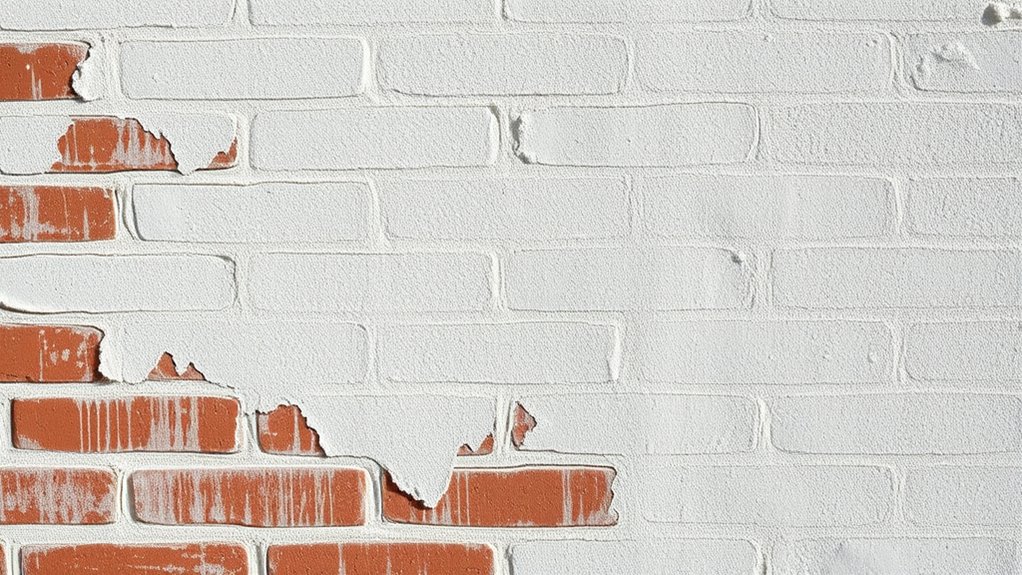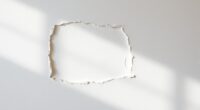When applying limewash to brick, start with thorough cleaning and surface repairs to guarantee good adhesion. Use the right limewash product suited for your brick type, and apply in thin, even coats, allowing each to dry fully. Avoid rushing the process, applying in poor weather, or skipping repairs. Regular maintenance, like gentle cleaning and timely touch-ups, helps your finish last. Keep exploring these tips to create a beautiful, long-lasting limewashed brick surface.
Key Takeaways
- Thoroughly clean and repair the brick surface before applying limewash for optimal adhesion and appearance.
- Apply limewash in thin, even coats during suitable weather conditions to prevent cracking and uneven drying.
- Match limewash type and color to the brick’s porosity and original aesthetic for a cohesive, durable finish.
- Avoid applying limewash during extreme temperatures, high humidity, or adverse weather to ensure proper curing.
- Regularly inspect and clean limewashed brick, and use breathable sealants to maintain longevity and prevent damage.
Preparing Your Brick Surface Properly

Before applying limewash to your brick surface, it is vital to prepare it properly. Start by cleaning the bricks thoroughly to remove dirt, dust, and loose debris, ensuring an even application. Next, assess the color matching, so the limewash blends seamlessly with your existing structure or desired aesthetic. If necessary, you can test small areas to see how the color develops once dry. Proper preparation also considers environmental impact; avoid using harsh chemicals that could harm nearby plants or wildlife. Additionally, understanding the color accuracy of your limewash helps achieve the desired visual effect. A clean, well-prepared surface helps the limewash adhere better and reduces the need for frequent touch-ups, making your project more sustainable. Taking these steps ensures a smooth application and long-lasting finish with minimal environmental footprint, especially when selecting eco-friendly preparing surfaces techniques. Being aware of risk assessment in the process can help prevent potential issues during application and ensure durability. Moreover, employing proper surface testing methods can further guarantee the longevity and aesthetic quality of your limewash coating.
Choosing the Right Limewash Material
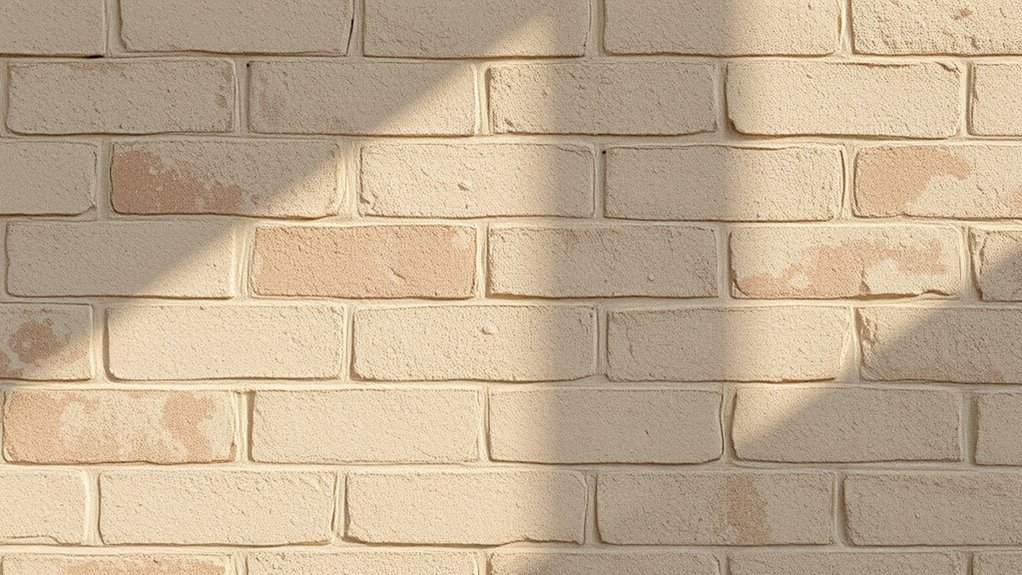
When choosing a limewash, you need to think about its material composition and how well it works with your brick surface. Different options offer varying durability, appearance, and ease of application, so picking the right one is essential. Make sure the limewash you select is compatible with your brick to achieve a lasting, attractive finish. Additionally, understanding the safety considerations involved in application can help ensure your project is both effective and secure. Being aware of data privacy challenges can also be important when researching products or consulting with professionals online. Considering the type of limewash, such as traditional or modern formulations, can influence the overall outcome and maintenance requirements of your project.
Material Composition Options
Choosing the right limewash material is essential for achieving the desired finish and durability on your brick surface. You should consider options that enhance historical authenticity, especially if you want your project to reflect traditional craftsmanship. Limewashes made from pure lime and natural pigments often provide an authentic look that ages gracefully over time. Additionally, these materials offer environmental benefits, as they are non-toxic, breathable, and sustainable. You have the choice between traditional lime putty, which has a longer curing time but offers superior flexibility, and pre-mixed limewash, which is convenient and consistent. Selecting the appropriate composition guarantees your brick surface remains protected while maintaining the aesthetic and ecological qualities that make limewash a popular choice. Properly selecting your limewash material also ensures compatibility with traditional craftsmanship and enhances the longevity of the finish.
Compatibility With Brick
Selecting the right limewash for your brick surface hinges on ensuring compatibility, as not all limewashes bond equally or age well on different brick types. To achieve this, consider the brick’s porosity, mineral content, and historical context. Proper compatibility guarantees durability and preserves the brick’s appearance. Additionally, understanding the flushing mechanism of the limewash can impact its effectiveness and longevity. Being aware of the application techniques can also influence how well the limewash adheres and ages over time.
Applying Limewash Correctly for a Smooth Finish
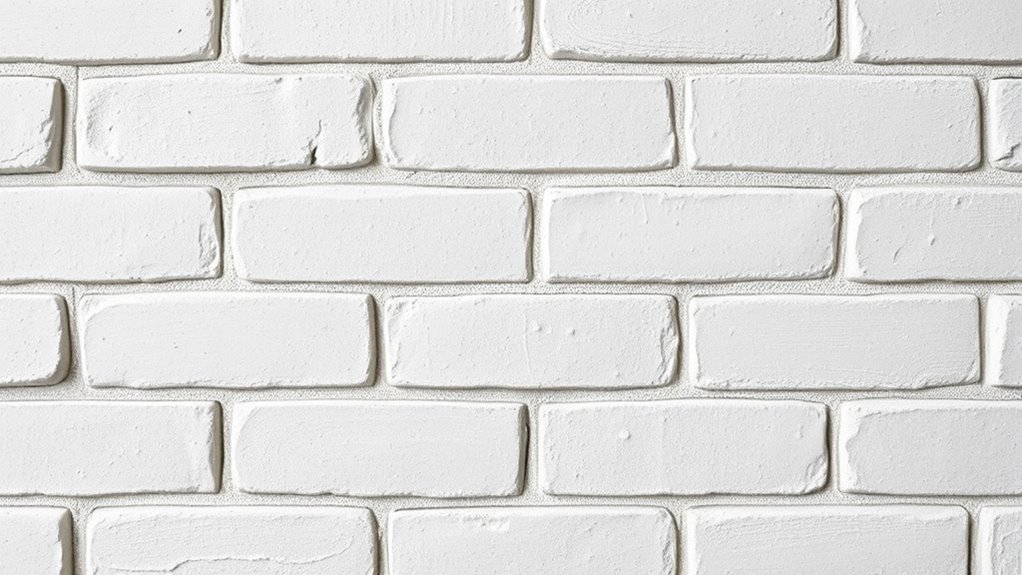
Before you start applying limewash, make sure you prepare the surface properly by cleaning and dampening the brick to guarantee good adhesion. Use consistent application techniques, such as working in even coats and maintaining a steady pace, to achieve a smooth finish. Paying attention to these points helps you create a beautiful, uniform look on your brick surface. Additionally, ensuring the surface has proper surface preparation can significantly impact the longevity and appearance of your limewash application. For optimal results, consider the climate conditions, which can influence how the limewash sets and adheres to the brick.
Surface Preparation Techniques
To achieve a smooth limewash finish on brick, proper surface preparation is essential. Start by cleaning the surface thoroughly to remove dirt, efflorescence, and loose particles. If needed, gently brush or rinse the brick with water. Repair any damaged mortar or cracks to ensure a stable surface. For historical accuracy, preserve original textures where possible, but smooth areas for a refined finish. Using eco-friendly options, opt for natural, breathable cleaning solutions that won’t harm the brick. Prior to applying limewash, dampen the surface slightly to improve adherence and prevent rapid drying. Consider the brick’s porosity and adjust your technique accordingly. Here’s a quick overview:
| Step | Purpose | Tips |
|---|---|---|
| Cleaning | Remove debris and dirt | Use gentle brush or water |
| Repairing | Fix cracks and mortar damage | Use lime-based repair compounds |
| Damping | Prevent rapid drying | Lightly mist with water |
| Smoothing surface | Enhance finish and texture | Sand or brush lightly if needed |
| Final inspection | Ensure surface readiness | Check for evenness and porosity |
Additionally, understanding the brick’s suction capacity can help determine the appropriate limewash application technique. Being aware of the brick’s porosity helps in adjusting the number of limewash coats needed for a uniform appearance. Recognizing the importance of surface prep can significantly impact the final result, ensuring durability and aesthetic appeal. Proper surface preparation also involves understanding the efflorescence that can sometimes appear on brick surfaces, which should be carefully removed prior to limewash application.
Consistent Application Methods
Achieving a smooth limewash finish requires consistency in your application technique. To guarantee color consistency, use the same brush or roller throughout and apply thin, even coats. Maintain a steady pace to prevent uneven textures or streaks. Proper drying techniques are essential; allow each coat to dry completely before applying the next to avoid blotches or mottling. Keep your tools clean and well-maintained to promote uniform coverage. Work in sections to prevent overlaps that can cause color variations. Monitoring the application process closely, and adjusting your approach if you notice inconsistencies, will help you achieve a professional-looking, smooth surface that highlights the beauty of limewash on brick. Additionally, understanding application techniques can help you achieve an even, durable finish. Being familiar with the self watering plant pots system can also inspire you to maintain your tools and workspace more effectively, ensuring consistent application results.
Avoiding Common Mistakes During Application

Applying limewash on brick can be straightforward, but it’s easy to make mistakes that affect the finish and durability. One common error is neglecting proper color matching, which can lead to an uneven or mismatched appearance. Take your time choosing the right shade to complement your brickwork. Additionally, overlook environmental considerations, such as weather conditions, which can cause the limewash to dry too quickly or unevenly. Applying during extreme heat, cold, or high humidity can compromise adhesion and finish. Always check the forecast and plan your application accordingly. Rushing through the process or skipping surface preparation can also cause issues. Pay close attention to these details to ensure a smooth, durable, and visually appealing limewash finish. Being aware of patterns in angel numbers can also help you time your project when energies are most favorable. Furthermore, understanding the science of sound vibrations can inspire a calming atmosphere during your workspace preparation, promoting focus and serenity. It’s also beneficial to familiarize yourself with proper surface preparation techniques to achieve the best results. Additionally, coordinating your work schedule with local gym hours can help you stay motivated and maintain a healthy routine while working on your project.
Maintaining and Caring for Limewashed Brick
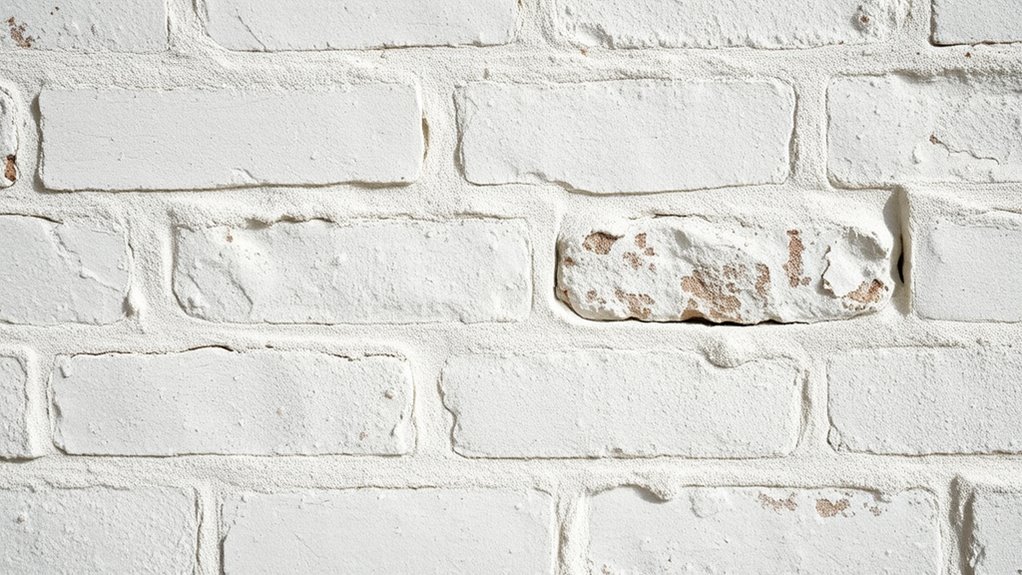
Maintaining limewashed brick requires regular care to preserve its appearance and durability. To keep the color vibrant, wash the surface gently with a soft brush and water to remove dirt and grime without stripping the finish. Avoid harsh chemicals that can damage the lime’s natural properties and negatively impact the environmental impact of your maintenance routine. Protect the brick from excessive moisture, which can cause deterioration or color fading over time. Consider applying a breathable sealant if necessary, but ensure it’s compatible with limewash to prevent trapping moisture. Regular inspections help identify early signs of wear or damage, allowing you to address issues promptly. Proper upkeep not only sustains the aesthetic appeal but also extends the lifespan of your limewashed brick.
Recognizing When to Reapply or Touch Up
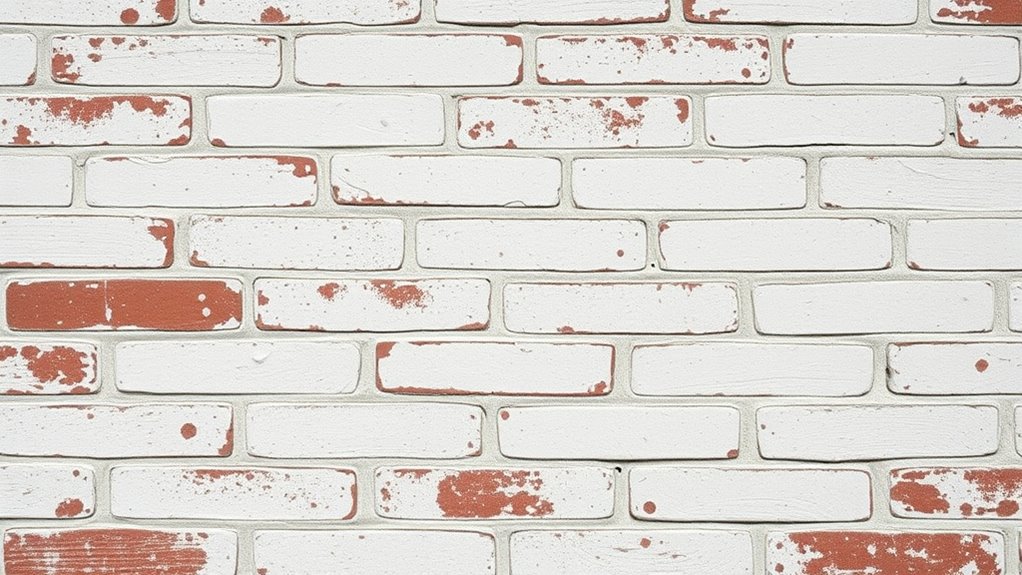
How can you tell if your limewashed brick needs a touch-up or a full reapplication? Look for signs like color fading, which indicates the limewash has worn down and lost its vibrancy. If the color has considerably dulled or uneven patches appear, it’s time to think about reapplying. Surface damage, such as cracks, chips, or peeling areas, also signals that a fresh coat is needed to protect the brick and restore its appearance. Small touch-ups can fix localized issues, but extensive fading or damage across large sections usually requires a complete reapplication. Regularly inspect your brickwork to catch these signs early, ensuring your limewashed surface remains durable and visually appealing.
Frequently Asked Questions
Can Limewash Be Used on Painted Brick Surfaces?
Yes, you can limewash over painted brick surfaces, but you need to do paint removal first. Start with thorough surface preparation by removing any loose or peeling paint. This guarantees the limewash adheres properly. Sand the surface lightly to create a better bond, and clean it well to remove dust and debris. Proper surface prep is key to achieving a durable, attractive finish on painted brick when limewashing.
How Long Does Limewash Typically Last on Brick?
Imagine your brick wall glowing with a soft, matte finish—that’s limewash’s charm. Typically, limewash durability lasts around 5 to 10 years, depending on climate and maintenance. With proper limewash maintenance, you can extend its lifespan, keeping your brick looking fresh and vibrant. Harsh weather may wear it faster, so occasional touch-ups are key. You’ll love how this breathable coating ages gracefully, adding character and charm over time.
Is Limewash Suitable for Exterior Brick Walls?
Yes, limewash is suitable for exterior brick walls, especially if you’re aiming for historical preservation and eco-friendly finishes. It allows the brick to breathe, reducing moisture buildup and protecting against weather damage. Plus, limewash enhances the authentic look of historic structures while being environmentally friendly. Just make sure to prepare the surface properly and apply in suitable weather conditions for lasting results.
Can I Customize the Color of Limewash?
Yes, you can customize the color of limewash like mixing a painter’s palette to create your desired hue. To do this, you’ll need to experiment with different pigments during color mixing, then apply using proper techniques for even coverage. Remember, limewash develops a unique, matte finish over time, so test small sections first. With patience and creativity, you’ll transform your brick wall into a personalized masterpiece.
Does Limewash Require Sealing After Application?
Limewash doesn’t require sealing after application because it offers natural durability and breathability. However, sealing can boost limewash’s durability and provide extra protection against stains and weathering. If you want to enhance its longevity and sealing benefits, applying a breathable sealant is a good idea. This helps maintain the aesthetic while increasing the durability of your limewashed brick, ensuring it stays beautiful longer with proper care.
Conclusion
Think of limewash on brick as a delicate dance—you need the right steps and timing to keep it looking stunning. By preparing properly, choosing quality materials, and applying with care, you’ll create a timeless finish that endures. Remember, maintenance is your encore, ensuring it stays vibrant over time. When you follow these do’s and don’ts, your brickwork will shine like a well-rehearsed performance—beautiful, resilient, and full of character.
